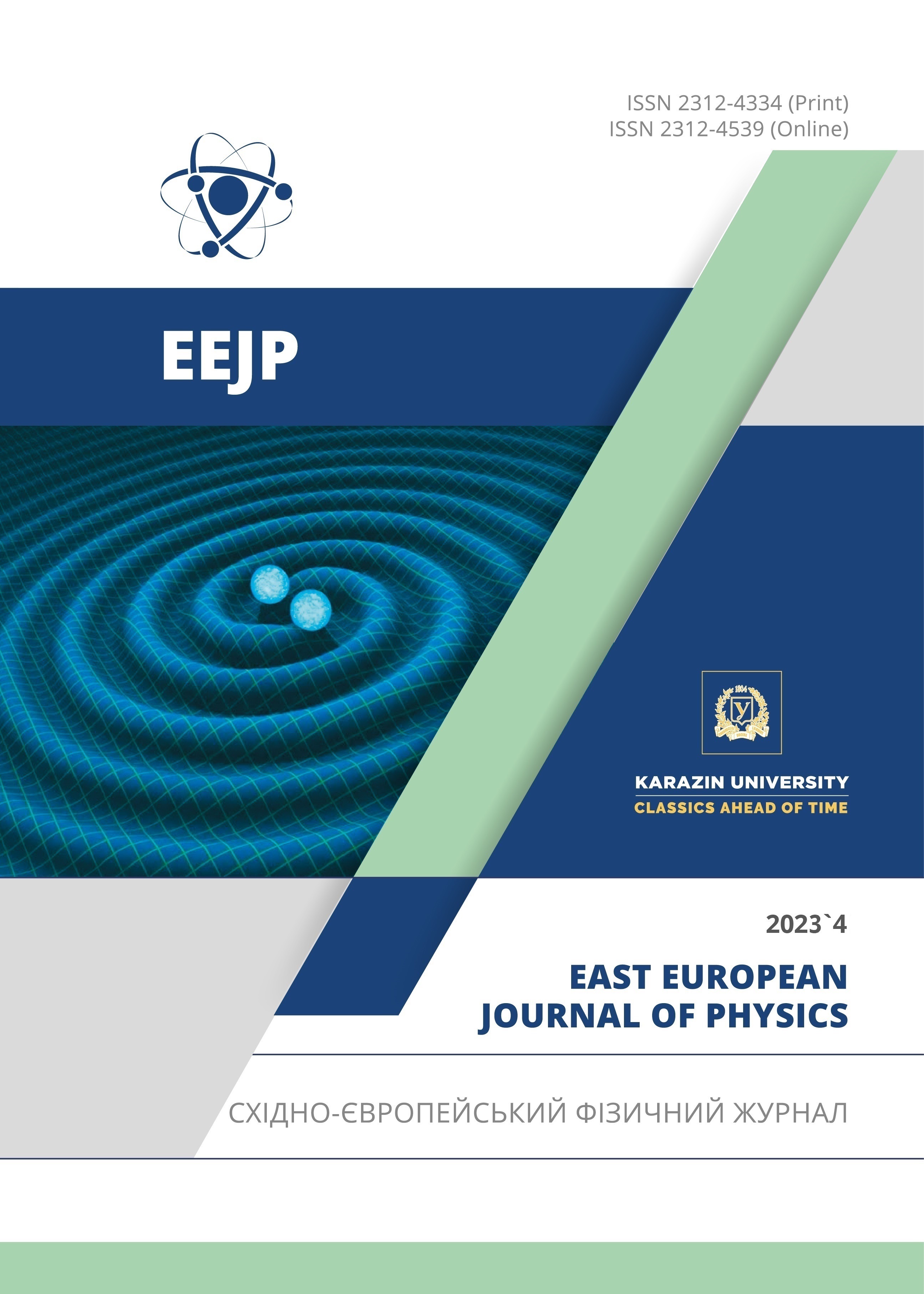Diffusion of High-Energy Negatively Charged Particles in the Field Atomic Strings of an Oriented Crystal
Abstract
The work analyzes the dependence of the diffusion index of high-energy negatively charged particles on the energy of the transverse motion in oriented crystal. The crystal had an axial orientation relative to the direction of particle incidence. The analysis was carried out using the example of π− mesons with a momentum of 100 GeV/c that impinged on a silicon crystal, which corresponds to the conditions achievable on secondary beam of the the CERN SPS accelerator. The analysis showed that the dependence under consideration is not monotonic. It has a minimum in the energy region slightly exceeding the value of the potential energy of particles at the saddle point of the potential of crystal atomic strings. At higher values of the energy of transverse motion of particles E⊥, the diffusion index increases with increasing E⊥, since this increases the average absolute value of the velocity of particle motion in the plane orthogonal to the crystal axis, near which motion takes plase. The increase in the diffusion index at low values of E⊥ is associated with the manifestation of incoherent scattering of particles on thermal vibrations of crystal atoms. The analysis carried out in the work is of interest both for a deeper understanding of the process of high-energy negatively charged particle beams passage through oriented crystals, and for improving methods for charged particle beams steering with a help of straight and bent oriented crystals.
Downloads
References
M.T. Robinson, and O.S. Oen, Phys. Rev. 132, 2385 (1963), https://doi.org/10.1103/PhysRev.132.2385
J. Lindhard, Mat. Fys. Medd. Dan. Vid. Selsk. 34, 1 (1965), http://gymarkiv.sdu.dk/MFM/kdvs/mfm%2030-39/mfm-34-14.pdf
W. Scandale et al., Phys. Lett. B, 760, 826 (2016), https://doi.org/10.1016/j.physletb.2016.07.072
W. Scandale et al., Eur. Phys. J. C, 78, 505 (2018), https://doi.org/10.1140/epjc/s10052-018-5985-8
A.G. Afonin et al., Instrum. Exp. Tech. 59, 196 (2016), https://doi.org/10.1134/S0020441216020019
W. Scandale et al., Phys. Lett. B, 733, 366 (2014), https://doi.org/10.1016/j.physletb.2014.05.010
I.V. Kyryllin, and N.F. Shul’ga, J. Instrum. 13, C02020 (2018), https://doi.org/10.1088/1748-0221/13/02/C02020
S. Redaelli et al., Eur. Phys. J. C, 81, 142 (2021), https://doi.org/10.1140/epjc/s10052-021-08927-x
F.M. Velotti et al., Phys. Rev. Accel. Beams, 22, 093502 (2019), https://doi.org/10.1103/PhysRevAccelBeams.22.093502
R. Rossi et al. J., Instrum. 18, P06027 (2023), https://doi.org/10.1103/PhysRevAccelBeams.22.093502
W. Scandale et al., Nucl. Instr. Meth. B, 467, 118 (2020), https://doi.org/10.1016/j.nimb.2020.01.011
W. Scandale et al., Eur. Phys. J. C, 79, 993 (2019), https://doi.org/10.1140/epjc/s10052-019-7515-8
W. Scandale et al., Phys. Lett. B, 804, 135396 (2020), https://doi.org/10.1016/j.physletb.2020.135396
W. Scandale et al., Eur. Phys. J. C, 80, 27 (2020), https://doi.org/10.1140/epjc/s10052-019-7590-x
W. Scandale et al., Eur. Phys. J. Plus, 137, 811 (2022), https://doi.org/10.1140/epjp/s13360-022-03034-6
I.V. Kirillin, Phys. Rev. Accel. Beams, 20, 104401 (2017), https://doi.org/10.1103/PhysRevAccelBeams.20.104401
I.V. Kyryllin, and N.F. Shul’ga, Eur. Phys. J. C, 79, 1015 (2019), https://doi.org/10.1140/epjc/s10052-019-7517-6
L. Bandiera et al., Eur. Phys. J. C, 81, 238 (2021), https://doi.org/10.1140/epjc/s10052-021-09021-y
T.N. Wistisen et al. Phys. Rev. Accel. Beams, 19, 071001 (2016), https://doi.org/10.1103/PhysRevAccelBeams.19.071001
L. Bandiera et al. The Eur. Phys. J. C, 81, 284 (2021), https://doi.org/10.1140/epjc/s10052-021-09071-2
A.I. Akhiezer, and N.F. Shul’ga, High energy electrodynamics in matter, (Gordon and Breach Science Publishers, Amsterdam, 1996).
A.A. Greenenko, A.V. Chechkin, and N.F. Shul’ga. Phys. Lett. A, 324, 82 (2004), https://doi.org/10.1016/j.physleta.2004.02.053
V.V. Tikhomirov. Probl. Atom. Sci. Tech. 3, 164 (2007), https://vant.kipt.kharkov.ua/ARTICLE/VANT_2007_3/article_2007_3_164.pdf
N.F. Shul’ga, I.V. Kirillin, and V.I. Truten’, J. Surf. Investig. 7, 398 (2013), https://doi.org/10.1134/S1027451013020468
D.S. Gemmell. Rev. Mod. Phys. 46, 129 (1974), https://doi.org/10.1103/RevModPhys.46.129
M.F. Shulga, V.I. Truten, I.V. Kirillin, The Journal of Kharkiv National University, physical series: ”Nuclei, Particles, Fields”, 887, 54 (2010), https://core.ac.uk/download/pdf/46589346.pdf (in Russian)
P.A. Doyle, and P.S. Turner. Acta Crystallogr. A, 24, 390 (1968), https://doi.org/10.1107/S0567739468000756
I.S. Gradshteyn, and I.M. Ryzhik, Table of Integrals, Series, and Products, 7th ed. (Academic Press, London, 2007).
K. Levenberg. Q. Appl. Math. 2(2), 164 (1944), https://doi.org/10.1090/qam/10666
D.W. Marquardt. SIAM J. Appl. Math. 11(2), 431 (1963), https://doi.org/10.1137/0111030
Copyright (c) 2023 Igor V. Kyryllin, Mykola F. Shul’ga, Oleksandr P. Shchus

This work is licensed under a Creative Commons Attribution 4.0 International License.
Authors who publish with this journal agree to the following terms:
- Authors retain copyright and grant the journal right of first publication with the work simultaneously licensed under a Creative Commons Attribution License that allows others to share the work with an acknowledgment of the work's authorship and initial publication in this journal.
- Authors are able to enter into separate, additional contractual arrangements for the non-exclusive distribution of the journal's published version of the work (e.g., post it to an institutional repository or publish it in a book), with an acknowledgment of its initial publication in this journal.
- Authors are permitted and encouraged to post their work online (e.g., in institutional repositories or on their website) prior to and during the submission process, as it can lead to productive exchanges, as well as earlier and greater citation of published work (See The Effect of Open Access).








